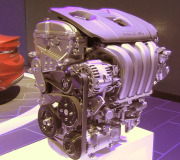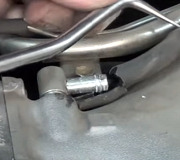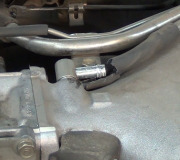CARADIODOC I am hoping to GOD you will reply, you seem like the only person who could help! I have a 2003 Jeep Grand Cherokee 4.0L with seemingly the same symptoms as JFAZIO5188!
2003 Jeep Grand Cherokee 4.0L 2WD
I work for a small repair shop so I have access to a full system scanner Autel Maxysis
Symptoms are:
*A rough idle. No stalling. No codes of any kind and I have run the misfire counter test which decreases the threshold for counting a misfire so you can see more of them and I only saw it count like 1 or 2 misses on random cylinders over multiple tests which lasted about 2 minutes each. Which I believe does not dignify a true miss.
* VERY bad mileage (8-10 mpg average, even though the INFO center tells me a much higher number (15-20mpg average). (Original specs list at 17/24mpg)
* VERY Negative Long Term Fuel trims (-15% @ idle and I've seen up to -27% upon acceleration), Short term seems like its normal, bouncing around -5 to +8%
* If this makes any sense, A STRONG idle, Not HIGH. It sits at about 500-600 in neutral or drive but in drive I have to apply a good amount of pressure to the brake to stay still. I have had a steel trailer attached to it with a few hundred pounds on it, and the truck will STILL climb up a small incline if I let off the brake and without touching the gas.
* if you TAP (almost like a flick) the gas pedal while in park/neutral, the RPM will drop for a split second as if its about to stall, before the RPM rises. Where as in customer’s jeeps with same generation and engine, the idle comes up immediately, instead of acting like it’s about to stall first
* I also noticed if I take a long highway trip, VERY rarely does it have a split second hiccup ( as if it misfires only once).
New Parts and Things I've done:
*Re-maned engine! This truck came into the shop with a totaled motor so I bought it off the guy and replaced it for myself *(see bottom for amazing story about why)*
* Cleaned throttle body and inside of intake thoroughly when engine was being replaced
* New plugs with engine (Autolite, I recently found out Champion is OEM, thinking about swapping?)
* New front O2s in attempts to fix this issue
* New fuel pump and filter/regulator (Pressure at 55psi key on OR running)
* New TPS because the connector was broken when I bought it
* I Cannot find any Vac leaks besides the throttle plate shaft which I’m told is allowed to leak a bit, although with the throttle body in hand it feels like the shaft might have a very tiny amount of play in it
* I swapped the IAC with a used one AND a new one and no change so I put old one back on
* Cleaned MAP sensor hole and throttle body, and found a Voltage test procedure and used a hand vac pump and looked at V on scanner as I changed the vac
> (Target pressure -- test says should be VS what I got, respectively ).
@ 0 inHg -- 4.8V vs 4.65V (this one bothers me a bit because I cant blame the hand pump)
@ 5 inHg -- 3.9V vs 3.94V
@ 10inHg --3.1V vs 2.9V
@ 15inHg -- 2.1V vs 1.9V
> I feel like it got pretty close to the test values based on not knowing how accurate my hand pump gauge is. Should I still blame the MAP after these results?
* Tested and even Swapped the Purge Valve with a used one (test okay, clicks with scan tool at various speeds) and no change when swapped.
* Swapped the Coil rail with a known good one (no Change)
* Swapped all 6 injectors with Upgraded 12 port Bosch Injectors that are said to smooth idle, increase power and some cases increase fuel eco (no change, although at the time I did not know if the fuel eco was bad or fuel trims because I was going off the INFO center and was happy with the numbers, I was just trying to get rid of the rough idle)
* I had an EVAP leak code for a long time that I couldn't figure out but I just recently changed the Leak Detection Pump and the vent valve because the pump was leaking and the vent valve was so worn out that it was not working right. Since ive done those the EVAP code has not come back but fuel trims have stayed the same if not worse.
* one thing I find strange is that on the scan tool there is a test for the IAC where its supposed to raise the idle to a set amount (800, 900, 1,000, 1,100, . 2,300) whatever you choose, and I believe its supposed to hold it at that RPM untill you stop it. But I tried it and the only thing it does is raise the idle to about 800 for a split second and then it comes back down, no matter what selection I choose, even when I had the brand new OEM one in there. BUT the "out of engine" IAC range test ( back and forth) seems to work fine.
* one modification I did do is swap the OEM muffler with a masterflow to change the sound of the exhaust. Hopefully the change in back pressure isn’t causing this issue?
***** NOW. Here is the KICKER! And dont think im crazy!
I live in south FL (elevation 0-15ft) where the temp doesn't really deviate from 80-95deg F too much and the humidity is never really below 70-80%.
I have noticed that the idle is Especially rough during a hot day (85-95) and seems a lot milder at night or on cooler days (65-75deg).
NOW. I just took a trip up to North Carolina and when I pulled into the campground, Elevation 6,600ft and about 30-50 deg F, the idle was so smooth I couldn't even tell the truck was running! And the "strong" idle I mentioned earlier was GONE, no heavy brake needed! I actually had to give it a little gas to get out of the mud/grass! Unfortunately I did not have the scanner to read Fuel Trims and the driving was so random that I could not calculate fuel eco. But On the way back down VERY FIRST STOP in Florida The idle was rough again! Which makes me think it is a MAP sensory or a temp sensor. P.S. After it sits over night, ambient temp, coolant temp, and intake temp read: 82, 82.4, 84.2 deg F respectively, on the scanner. Seems like the intake sensor might be off a few degrees?
*** Reason it needed an engine*** The previous owner neglected the leaking radiator and allowed the engine to overheat. So He finally brought it in to the shop for a “loud clanking noise.” Turned out that the engine got so hot that one of the piston heads broke off the arm and got stuck in the cylinder. This allowed the piston arm to whip around the crank case freely as the engine spun! We started that sucker 2x/day to pull it in and out of the shop for almost two weeks before the engine finally locked up! I heard that the Inline 6 4.0L jeep motor was reliable but I still cant believe that engine still ran for so long!
Thursday, January 10th, 2019 AT 5:23 AM




